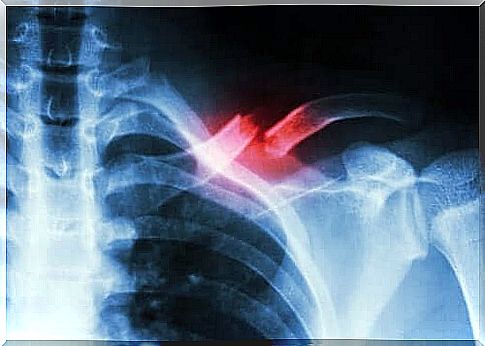What Is A Stress Fracture And How Does It Develop?

A stress fracture occurs when a small, incomplete break in a skeletal bone is caused by something other than a strong impact. This injury is usually caused by repetitive movements or by a rapid increase in the amount and/or intensity of an activity.
These types of fractures are not easy to diagnose. Therefore, they require a visit to a medical specialist and additional tests to distinguish it from other conditions. This is because the fracture is usually not detected on an X-ray.
Athletes are most exposed to stress fractures. In fact, 2% of sports injuries consist of these types of fractures. It is often quite painful and there is always a risk that the broken parts of the bone can shift.
What is a stress fracture?

A stress fracture is an incomplete fracture that can occur as a result of overuse from physical activity. When there is no continuity in the bone tissue, there is a fracture.
Most of these injuries result from a blow or other trauma. However, in the case of a stress fracture, often the cause of the problem is just weakness or fatigue:
- There is weakness when there are deficiencies, as is the case with osteoporosis.
- On the other hand, fatigue is when the muscles are overused as a result of repetitive or unusual activities.
A stress fracture is actually a type of splinter or an incomplete tear of the bone. It arises as a result of repeated microtrauma or overload, as we mentioned above. In addition, a stress fracture can cause severe pain when performing certain physical activities. They often disappear when the activities are stopped.
You may not know it, but bones are made up of mineralized connective tissue. This is a connection that makes it easier to repair the bone when exposed to overload. The body is able to break down damaged tissue and reabsorb it and then reshape it.
However, if the impact is continuous or too sudden due to overload, the damage exceeds our body’s ability to replenish bone tissue. This is exactly what happens when there is a stress fracture, due to overexertion, repetitive movements or osteoporosis.
Types of Stress Fractures
There are two groups of stress fractures: low-risk and high-risk. We will discuss these groups in more detail below. The classification is based on factors such as:
- the affected area
- the presence of pseudoarthrosis
- the potential for complications
- the healing time
- the way the fracture healed.
Low Risk Fractures
These stress fractures are treated simply with the elimination of the activity causing the injury. In general, these stress fractures mainly occur in:
- the upper limbs
- ribs
- beaks
- thigh bone
- shinbone
- lumbar vertebrae
- fibula
- calcaneus
High Risk Fractures
This type of stress fracture has a significantly higher potential for complications. This is because it often involves injuries to body parts such as:
- the femur neck
- tibial malleolus
- carpal bone
- ankle bone
- the base of the metatarsus
Where do stress fractures occur?

A stress fracture can affect a large number of bones in our body that are repeatedly overloaded for one reason or another. However, feet have the highest risk of developing a stress fracture. The most common stress fractures in feet include:
- Fracture of the second metatarsal bone. This is the most common stress fracture because this bone is connected to the big toe, which is most stressed during sporting activities.
- Fracture of the fifth metatarsal bone. This stress fracture is typical of all activities that require lateral shifts and jumps.
- Calcaneal fracture. This usually occurs in activities where the primary support rests on the heel.
- Astragalus fracture. This is not very common and it is not specific to any particular activity or sport. However, it is a great inconvenience when this fracture has occurred.
- Fracture in the medial malleolus of the ankle. This is typical for activities involving long distance jumps and/or running races such as a marathon.
In addition, it is relatively common for a stress fracture to occur in other parts of the body. In particular, this can happen in the fibula, the pelvis, the femoral neck, the sesamoids of the foot (the sesamoid bone), and the epiphysis of the fibula.
Closing Notes
There are stress fractures that are typical of any discipline from the point of view of any sport. Stress fractures of the midfoot are more common in marathon runners, soccer players, dancers, and volleyball players.
A fracture of the first rib, on the other hand, is more common in handball players. In golfers, there is usually a stress bill of the lower ribs. If you play a sport and notice pain during certain movements, see your doctor. A stress fracture could be the cause.









